Calathea ornatas grow uprightly as small bushes. At full height Ornata species grow to about two feet tall and wide. The Ornata pinstripes offer sophistication and a stylish focal point to your home or office place.
The dark green leaves of the Pinstripe ornata have stripings that honestly look styled by an artisan painter. The undersides of the leaves are deep purple. It’s a stunning effect.
The leaves move gently throughout the day to position themselves to the light. At night they fold up and in the morning open to the light. This fascinating process is nyctinasty.
Calatheas are an interesting plant group. They are included in the Marantaceae plant family along with arrowroot. They are related to the well known Marantas. And are often confused as praying hands plants.
These plants grow in the rain forests of Brazil. They live on the forest floor in high humidity, moist soil and warmth. Do your best to replicate these conditions if you want a healthy plant.
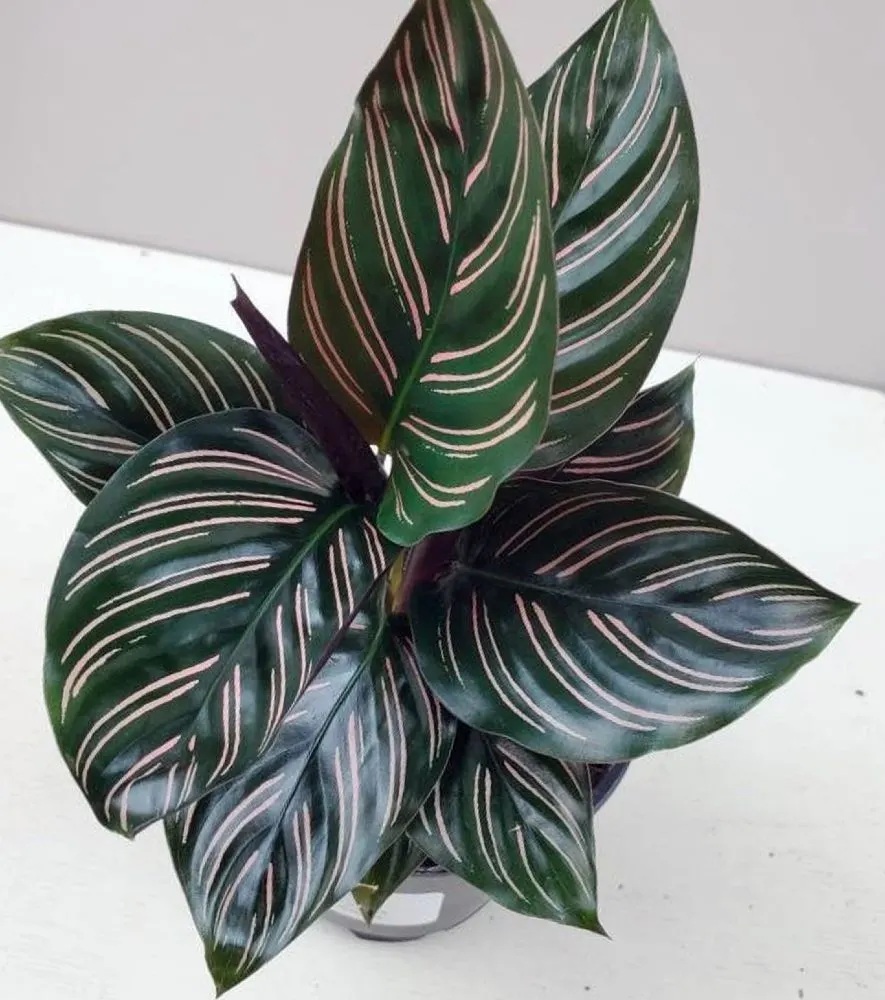
Our care guide will explain all the details of how to properly care for Ornata varieties.
Recently a reclassification of the Calathea ornata has put it in the Goeppertia genus with about 250 other formerly Calathea species. The new scientific name is Goeppertia Ornata.
The Ornata is commonly known as the pinstripe calathea, calathea pinstripe, calathea ornata pink and calathea ornata sanderiana. In time that may change. but for now I’m seeing calathea on all the plant name tags at the plant shops.
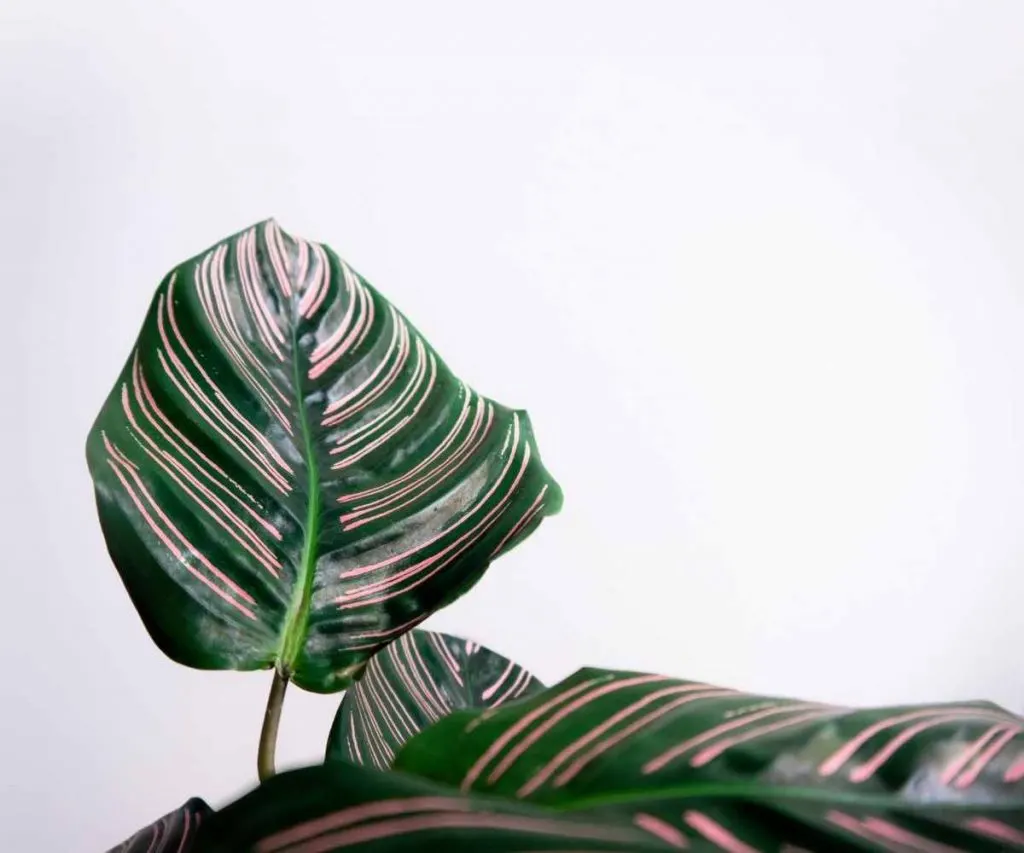
The ornata has a few cultivars you will see in the shops. The beauty star and calathea white star are both ornata cultivars.
Calathea White Star Vs. Ornata Pinstripe
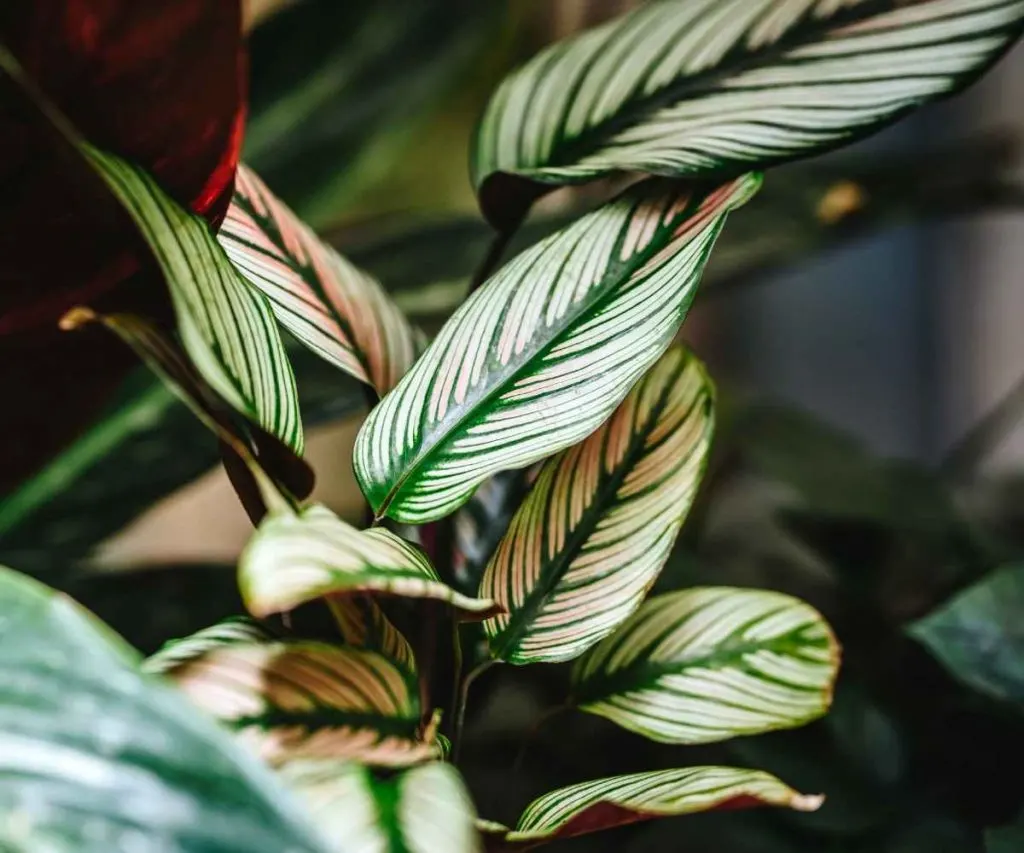
The Majestica White Star calathea has some pink on it like the pinstripe. The pink will change as the plant grows. The white stripes will become more distinct as the plant matures.
Unlike the pinstripe ornata, the striping pattern of the White Star is densely packed. The leaves are long and narrow growing on long stems.
Even though the white star is similar to the pinstripe you won’t confuse them. I own both and they each have something unique to offer your home.
Calathea Beauty Star Vs. Ornata:
Another favorite ornata cultivar is the Calathea Beauty star (Goeppertia ‘Beauty Star’).
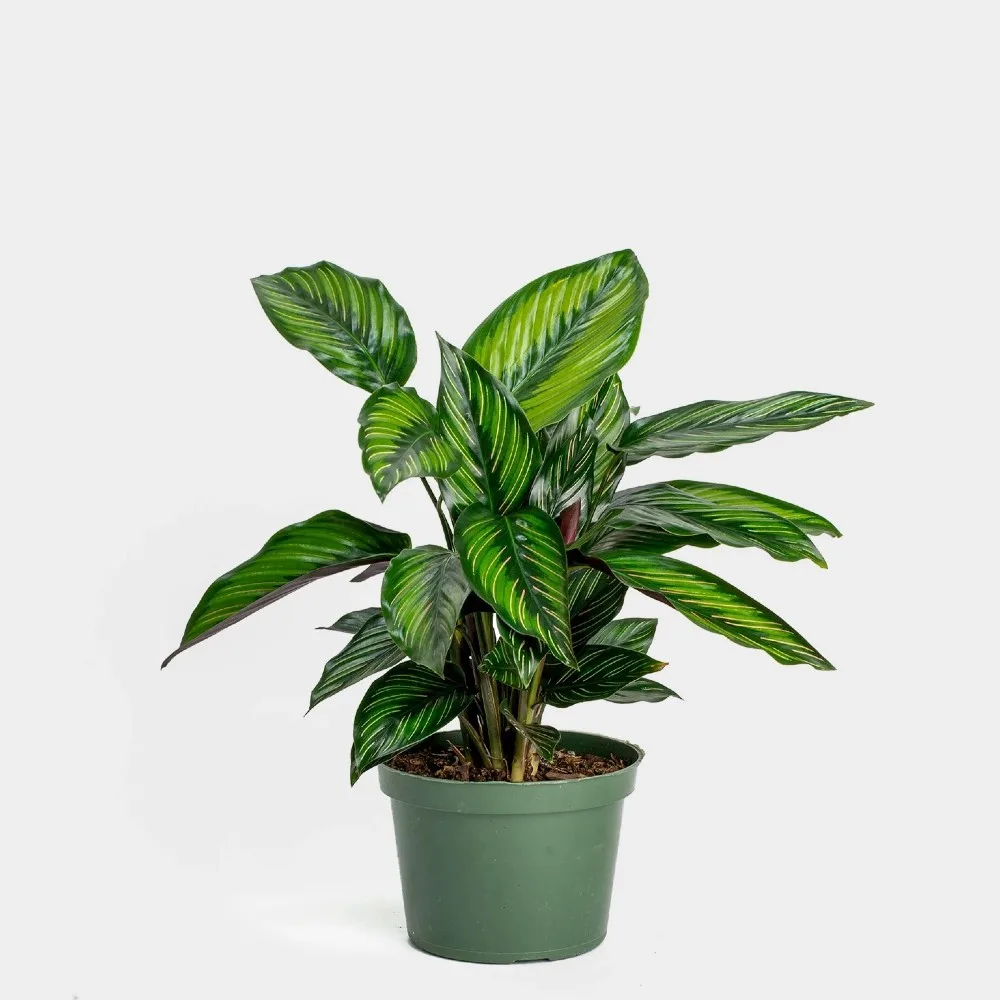
I also own the Calathea beauty star. I really love it’s patterning. This plant is similar to the pinstripe in the stripe spacing and leaf shape and bushiness of the plant.
However, the beauty stars add light green highlights on each side of the rib and through the leaves with a dark green perimeter. It’s a beautiful showy plant.
Air Filtering and Non Toxic Plants:
All Calatheas and other praying hands genus’ are non toxic to humans and pets. They also filter the air and improve the air quality in your home or office.
One plant cannot remove all toxins from the air. but they do help. if you have a true love of Calatheas fill your home with them and enjoy this non toxic air improving plant.
How to Care for Calathea Ornatas:
They make lovely plants for the table top, shelves or even a corner on the floor if you can keep it out of drafts.
These are finicky plants that need more attention than easy care plants like Pothos, Tradescantias and snake plants. The sophisticated foliage and interesting leaf movements make them worth learning about and caring for.
Calthea ornata leaves curling or browning at the tips and edges indicates plant stress. Most likely watering problems, or temperature or light conditions.
These plants will complain with poor color, drooping leaves and stems or brown crisping and curling leaves when they are not happy. If you correct the conditions to suit your plant they will rebound if the problem is not too far gone.
Our care guide will show you how to properly support these plants for optimal growth. Help them thrive in your home by learning what they need. We offer lots of tips and ideas on their care.
Calathea Ornata Care Guide
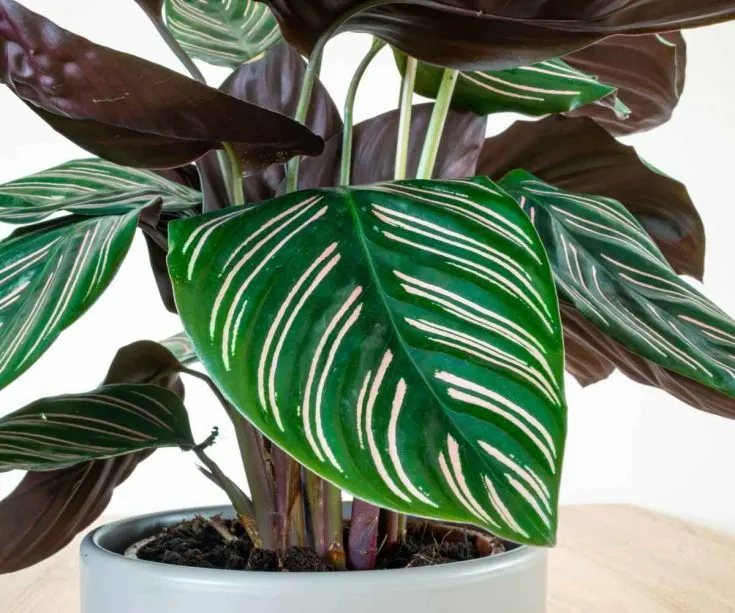
Calathea Ornatas are beautiful, exotic plants with wide appeal. Their care needs are specific and important. These are sensitive plants. This is Not a forgiving plant group.
Once you find the perfect growing conditions for your Pinstripe calathea it will perform well for you.
Learn what they need and give it to them. Their lovely foliage (in some cases they even flower) are so worth the effort!
All Calathea plant care is similar. No matter what type you own this care guide will apply. Put Ornatas in the more demanding group.
Materials
Instructions
Soil Preference:
- Calatheas enjoy a light well draining soil.
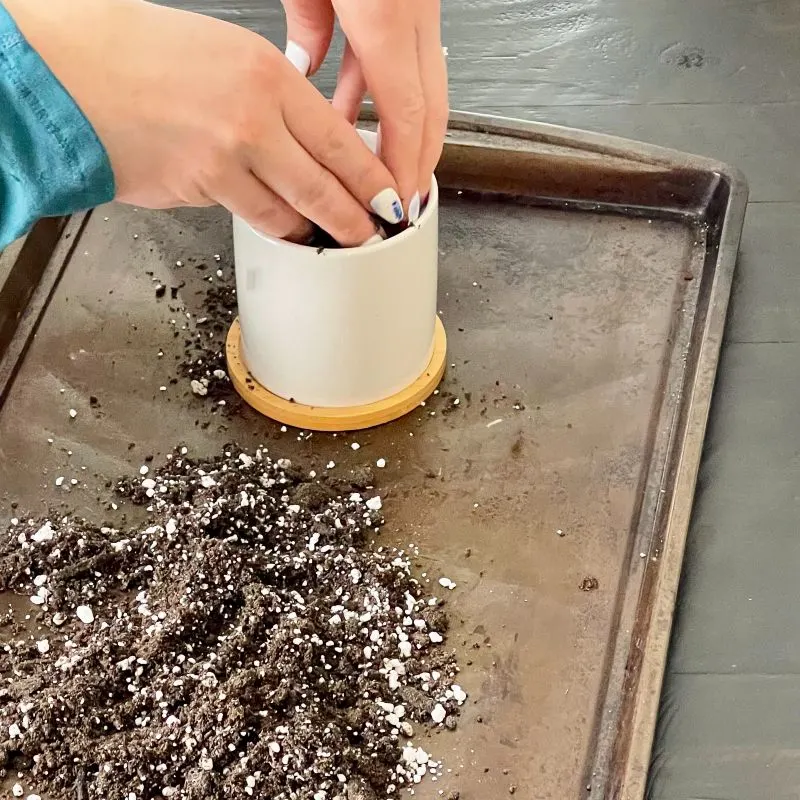
- A mix of potting soil and perlite will keep the roots happiest.
- Our mix for this plant is 70 % potting mix to 30% perlite.
- A heavy soil potting mix is not recommended for these plants.
Pot Size and Type:
- Calatheas grow from rhizomes. And they grow new offshoots to the sides of the mother plant.
- This means they will fill a pot out as a wider plant eventually. Quite a nice table top centerpiece..
- Calatheas will grow to the size of its pot. If you leave it to grow as a grouping in one pot you will need to find a pot that is shallower and has a wider circumference. They do not like to be overly root bound.
- If you want to encourage faster growth choose a pot about 2 inches wider in diameter than the current pot.
- Any well drained pot can be used. It MUST have excellent drainage.
- Terra cotta pots are not recommended. They will wick too much water away from the soil.
- Repot every second year or when roots come out the drainage holes on the pot bottom To the next pot size up.
- Don't jump to a huge pot from a small one unless you wish to encourage faster growth. Just go to the next size up pot.
- For Calatheas self watering pot systems work well. (linked above). They control the watering for you and help avoid root rot, overwatering and under watering.
- Calatheas enjoy evenly moist soil so self watering systems help here.
Lighting:
- Calatheas all enjoy indirect light for best leaf variegation and optimal growth.
- Ornatas leaves will fade in strong lights. Move to a less bright area and see if that helps.
- It will tolerate lower indirect light but the plant may grow more slowly. Leaf variegations may not be well expressed. In other words...it may fade from low light too.
- Shield this plant from strong direct light in summer south and west sunny windows. The leaves will burn and the colors will fade. Look for dry brown spots on the leaves and curling brown edges. If you see them move the plant to lower light.
- Tip: Window sheers or blinds can offset some brief periods of high direct light.
Watering:
- Calathea Orantas are very sensitive to the water you use. These are plants accustomed to soft acid water from rain forests. Hard water high in minerals and salts may cause trouble for them. Chemicals in your water (even water softeners) will also harm them.
- Let your tap water sit for 24 hours to allow any chemicals to dissipate. Filtered, rainwater or distilled water are recommended if you tap water is high in minerals.
- Water your Calathea when the soil is dry down an inch or so. Calatheas enjoy even moisture in the soil. But never let it sit in soaking wet potting mix.
- If your calathea leaves start to roll up and curl, the plant droops or the edges turn brown suspect watering problems.
- Under watering can show all the symptoms listed above. Adjust your watering or soil mix to accommodate.
- Over watering will end in root rot, grey mold on the leaves, algae growth on the soil and fungus gnats or other pests moving in.
- Try a watering schedule of once a week. But do not water if the soil is wet. Alternately, Do not let the soil dry out completely.
- Watering is best done on a regular schedule so the plant is not over or under watered. Both can cause stress.
- These tropical plants enjoy humidity of 40 to 60%.
- In dry climates this plant will thrive with a humidifier nearby. Or set it in your kitchen or bathroom. Frequent misting on a regular daily schedule will help.
- More humidity tricks: Set the plant on a pebble tray with water not touching the soil for added humidity as necessary. Grouping plants together will provide more humid conditions.
- In dormant winter months reduce watering to when the soil is dry down 2 inches .
- Never let this plant get wet feet. If the soil is compacted the bottom of the soil can remain wet which encourages, grey mold on the leaves, root rot and Fungus Gnats. If you see yellow leaves or brown curling leaf edges you are probably overwatering or Inconsistently watering.
- self watering planters are a good choice for calatheas. They remove many of the watering problems listed here.
How to Fertilize:
- Calathea Ornata requires a regular fertilizing schedule.
- Apply a good quality fertilizer (linked in materials) monthly through Spring and summer. This does NOT apply if you have slow release fertilizers in your potting soil. Be sure to read your soil labels.
- Decrease feedings by late Fall and allow your Calathea plant to rest through the winter months.
- Look for brown spots on the leaves of your plants. This may indicate an over concentration of salts in the roots from over feeding. It can burn the leaves.
- The remedy is to set the plant under a faucet of water and let the water run through for 10 minutes or so. Allow the pot to Completely drain. Discontinue fertilizer until the plant recovers.
Temperature:
- Optimal temperatures for Calatheas are 65 degrees F. to 75 degrees F.
- Ornatas are sensitive to cold drafts from windows and doors.
- In winter, beware heat vents blowing on your plant leaves. Calatheas cannot tolerate uneven heating, or drying heat vents or drafts.
Pruning and Training:
- Sharp Hand pruners are preferred for pruning. They will give a clean cut that will heal quickly.
- Cut off the leaves of Calatheas at the soil line.
- Pruning is usually done to shape the plant, remove old dead leaves or keep it small.
- Calatheas grow wider rather than taller. This makes them ideal table top or window sill plants.
Leaf Care:
- For the best care leaves enjoy occasional washing.
- This helps keep the stomata (leaf pores) open for plant respiration.
- Healthy leaves with a good clean surface are most able to resist pests.
- Dusty leaves will starve the plants of water exchange through humidity.
- Hand Wash the leaves monthly with water.
- You can also use a shower to clean off a calathea. Beware the water temperature. Keep it room temperature to avoid shocking the plant.
Pests:
- All plants get attacked by pests. Calatheas are especially susceptible to spider mites.
- Stress by longterm poor watering practices, poor light, extreme temperatures and soil conditions are contributors to pests. Fungus gnats will set up house in the soggy soil of an overwatered plant.
- Washing the plant leaves occasionally will help keep pests from establishing themselves on the plant.
- Spider mites are the biggest problem for Calathea plants. Watch for the webs. Treat immediately and continue for two weeks or more to remove the next generation of spider mites after the adults die. Eggs attach to the leaves and cannot be washed off easily.
- Mealy bugs, scale, thrips and whitefly are also common houseplant pests you will see in a stressed Calathea.
- Read our post on How to get rid of aphids and other pests with our homemade pesticide soap recipe or neems oil.
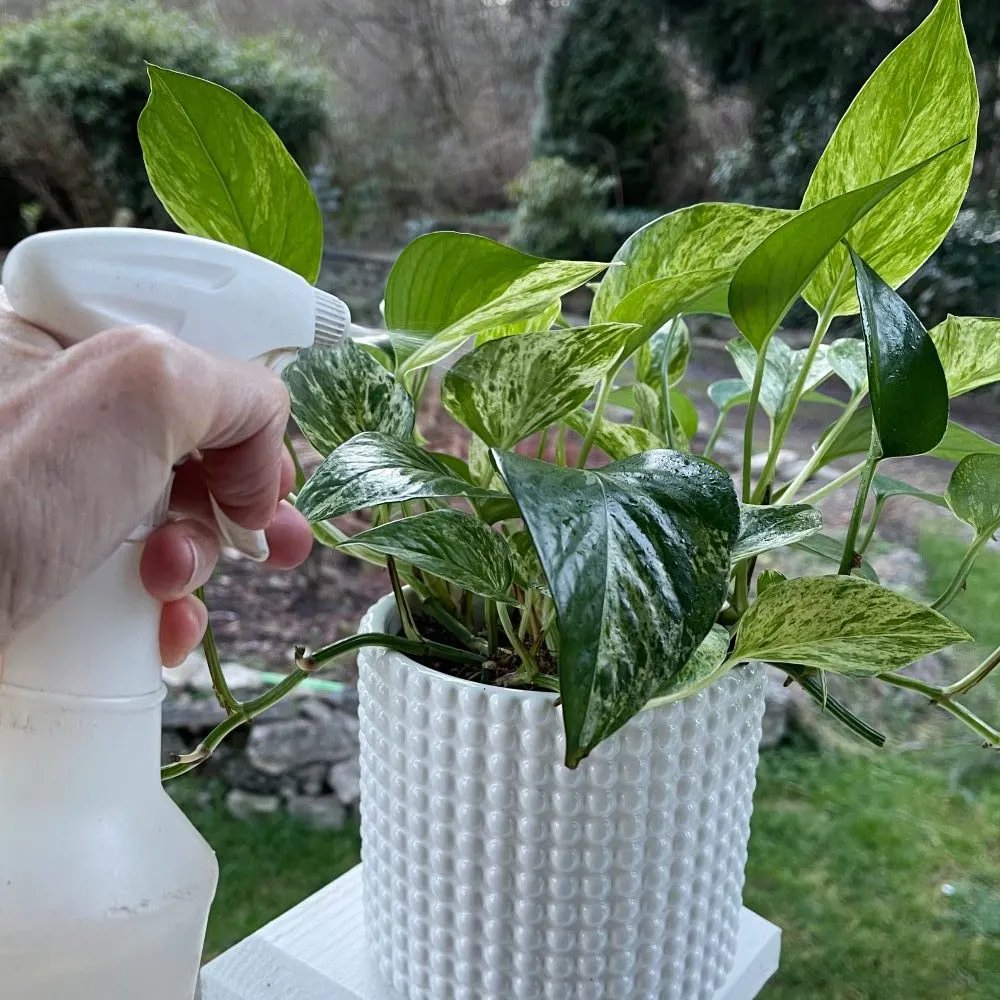
- To minimize the possibility of pests be sure to check all nursery plants before bringing them home. Carefully examine the top and bottom of the leaves.
- Do NOT purchase plants with signs of pest damage or disease.
- Quarantine all new plants until you are sure no pests live in them.
How to Propagate Calatheas:
- Propagation is best done through root division.
- Seed propagation can be done but the seeds can be difficult to source.
- Dividing a calathea is easiest when repotting it in spring or summer.
- Unpot the plant gently. Look at the root system. If the plant is mature you should see a natural parting in the leaves and roots. This is the two plants growing together.
- Gently pull the two parts to separate them. If the roots are heavily intertwined cut them as necessary with sharp sterile scissors or small pruners.
Pot the two plant sections in separate pots. In 2 to 4 weeks the divisions should be settled and growing.
Non Toxic Plant:
- All calatheas are non toxic to humans and pets. Still it not recommended to chew any houseplant.
- Biting or swatting are not good for the health of the plant.
- Also you don't know what chemicals, pests or pathogens are in the soil or fertilizers you use. So best practice is to keep houseplants away from pets and kids.
Care Summary and Plant Placement:
All Calatheas can be placed anywhere in your home that meets their needs.
- Keep them in the proper soil and regularly fed.
- Self watering pots will help keep the soil evenly moist.
- Set them in medium indirect light in a north or east facing window. Adjust the plant placement if the leaf colors begin to fade.
- Water only occasionally to keep soil moist but not soaked.
- Humidity level should be around 50%. 40 to 60% is the range various species are comfortable in.
- Temperature no lower than 60 degrees F. These plants prefer a stable heat of 65 to 75 Degrees F.
- Keep all Calatheas away from cold or hot drafts.
- Monthly leaf washing will keep the plant leaf pores open, reduce pests and hydrate the leaves.
Follow Us:
Find us on YouTube, Instagram , Pinterest and TikTok! We love to Plant chat. We also comment, like and occasionally share your content to our daily stories. We’d love to see your plants. Share your joy in your houseplants. Happy Planting!
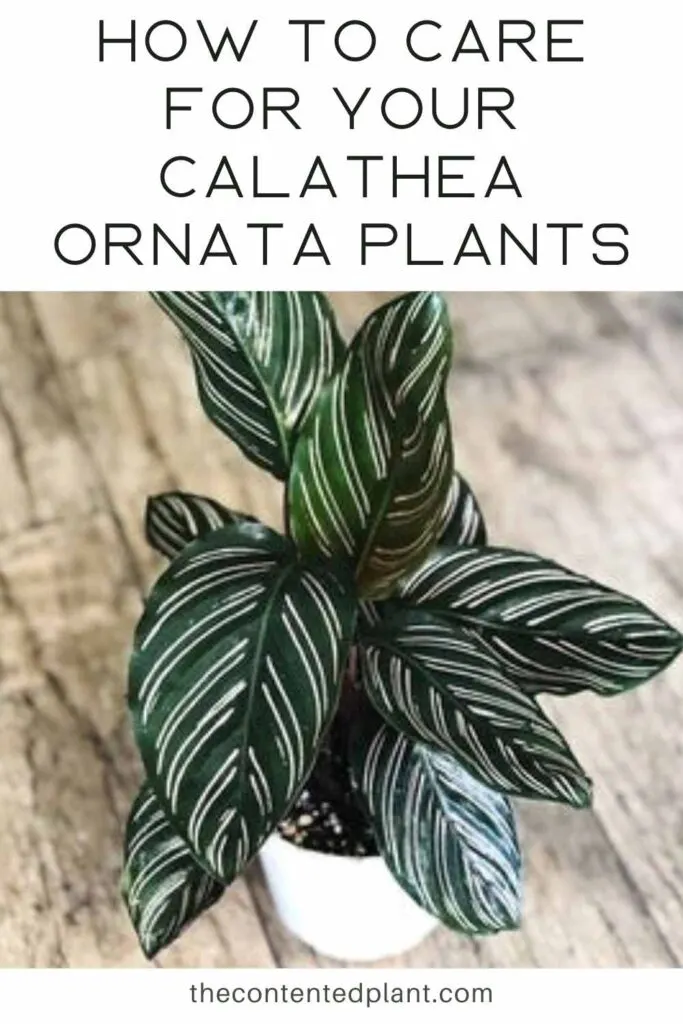

Begonia Maculata Care Guide and Tips - The Contented Plant
Friday 13th of May 2022
[…] Calathea ornata […]
Murdannia Loriformis-The Bright Star Plant - The Contented Plant
Friday 15th of April 2022
[…] Calathea Ornata Care guide and Plant Profile […]
Watering Plants Properly - The Contented Plant
Saturday 5th of February 2022
[…] out what the problem was in my Calathea collection. I lost my first Calathea before I learned. Sorry Pinstripe. […]
Calathea Makoyana Care Guide and Profile - The Contented Plant
Thursday 9th of September 2021
[…] pinstripe ornata was my teacher. It went from healthy foliage to a bare stem in the ground. I researched like mad. I […]
Calathea White fusion Care Guide and Plant Profile - The Contented Plant
Sunday 8th of August 2021
[…] is a plant that requires a little passionate loving. Like the Calathea ornatas and the lovely Zebrina the white fusion is not a beginners […]